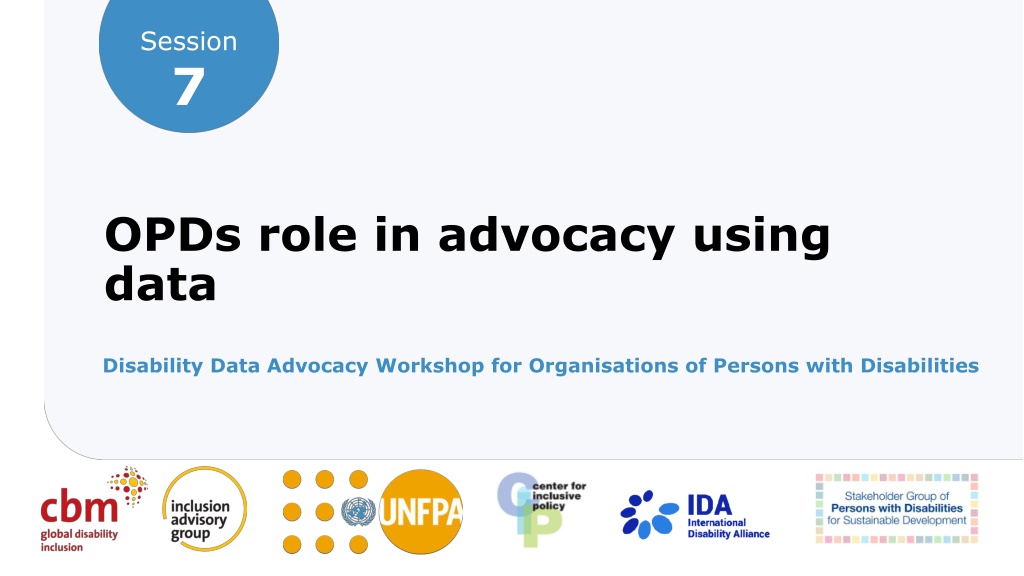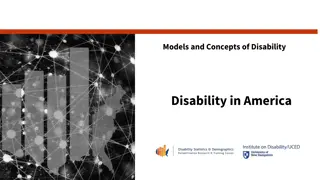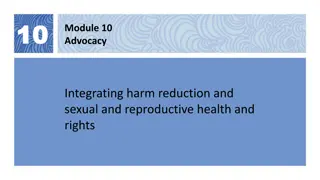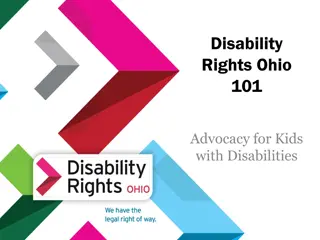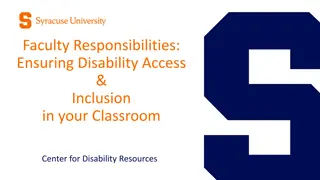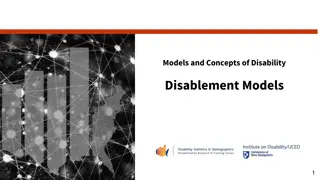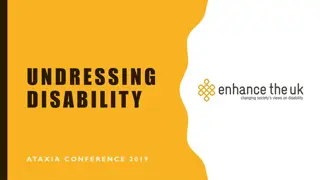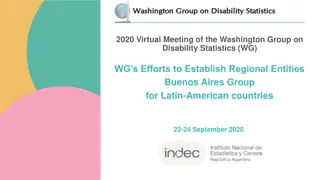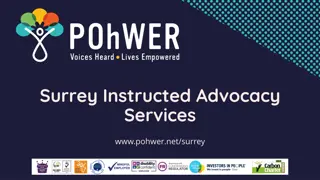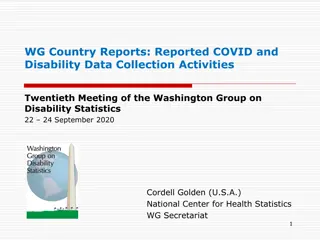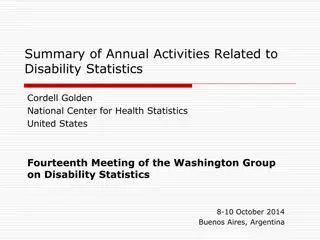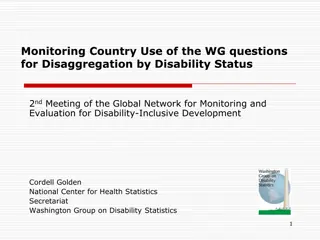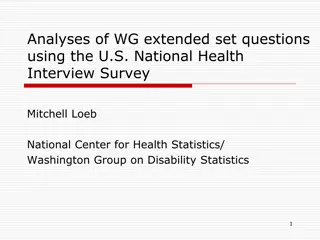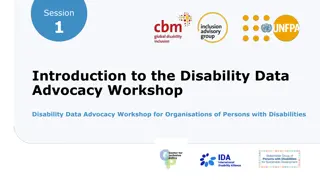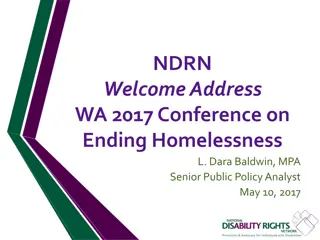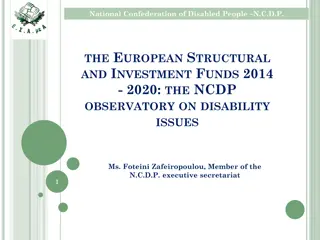Disability Data Advocacy: Empowering OPDs with Official Data for Advocacy
This workshop session focuses on empowering Organizations of Persons with Disabilities (OPDs) to advocate effectively using official data. It covers strategies for advocacy, creating strong data-based messages, and utilizing data to monitor progress and influence policy decisions. The importance of official data in strengthening advocacy efforts and the role of OPDs in promoting data-driven decision-making are highlighted.
Uploaded on Oct 06, 2024 | 0 Views
Download Presentation

Please find below an Image/Link to download the presentation.
The content on the website is provided AS IS for your information and personal use only. It may not be sold, licensed, or shared on other websites without obtaining consent from the author. Download presentation by click this link. If you encounter any issues during the download, it is possible that the publisher has removed the file from their server.
E N D
Presentation Transcript
Session 7 OPDs role in advocacy using data Disability Data Advocacy Workshop for Organisations of Persons with Disabilities
Session overview 2 Disability Data Advocacy Workshop for Organisations of Persons with Disabilities SESSION 7
Overview of session This session will: Provide information on how to advocate using data; Review approaches for supporting advocacy messages with strong data-based evidence with a focus on official data; Understand how to create and present advocacy objectives with data; Provide lessons learned and examples of data advocacy actions that can be taken. 3 Disability Data Advocacy Workshop for Organisations of Persons with Disabilities SESSION 7
How to advocate for better data 4 Disability Data Advocacy Workshop for Organisations of Persons with Disabilities SESSION 7
Building advocacy messages Data is commonly used in advocacy messages to: Show patterns or where change is needed. Highlight a key point, often a shocking situation. Overcome stigma and discrimination. Demonstrate the effectiveness of interventions. Share stories and highlight experiences. 5 Disability Data Advocacy Workshop for Organisations of Persons with Disabilities SESSION 7
Why should OPDs use official data in advocacy? OPDs can encourage governments to create policy decisions on data. Using official data strengthens the evidence base to compel governments to act. OPDs can monitor the progress of the CRPD, SDGs, and government programmes through data. Data is increasingly available, especially linkws with the CPRD and the 2030 Agenda. OPDs are increasingly able to compare data internationally due to the growing use of the Washington Group Questions and can use data to identify patterns and highlight key points. The reputation and influence of the OPD can be strengthened by using data. 6 Disability Data Advocacy Workshop for Organisations of Persons with Disabilities SESSION 7
How can OPDs use data to monitor the CRPD? In CRPD reporting processes: Review the Reporting Guidelines to understand the data being requested by the CRPD Committee for the State report. Examine the draft and final State report to see how it aligned with the requested data in the Reporting Guidelines. Identify inaccurate data or gaps in the draft State report and advise the government to address these before submitting to the CRPD Committee. Review how the data is being interpreted in terms of the CRPD requirements and identify any ways that data is being inappropriately interpreted to show progress in meeting goals. Use various data sources and findings of gaps and inaccuracies in the state report to inform the shadow report to the CRPD Committee. 7 Disability Data Advocacy Workshop for Organisations of Persons with Disabilities SESSION 7
What do the SDG indicators mean for OPD advocacy? The global SDG indicator framework has two significant features that can help OPDs create advocacy messages: 1. It requests that governments disaggregate any relevant SDG data by disability. 2. It spells out 11 disability-inclusive indicators that measure the SDGs. The global indicator framework states that SDG indicators should be disaggregated, where relevant, by income, sex, age, race, ethnicity, migratory status, disability and geographic location, or other characteristics... For example, the indicator Proportion of population with access to electricity can be disaggregated by disability. 8 Disability Data Advocacy Workshop for Organisations of Persons with Disabilities SESSION 7
How can OPDs use data to monitor the SDGs? Review the global indicator framework and the identified 32 critically important indicators that are recommended by OPDs and allies to be disaggregated by disability. Participate in national-level consultations and provide an analysis of gaps in the inclusion of persons with disabilities in achieving the SDGs. Engage in national SDG Forums, regional SDG forums and the global High-level Political Forum to continue to push for improvements to disability disaggregated data and to fill disability data gaps in achieving the SDGs. 9 Disability Data Advocacy Workshop for Organisations of Persons with Disabilities SESSION 7
Building evidence- based advocacy 10 Disability Data Advocacy Workshop for Organisations of Persons with Disabilities SESSION 7
Possible steps for using official data for advocacy The following steps outline the ways OPDs can use data to inform their advocacy: 1. Identify the advocacy objective. Sometimes available data can inform the advocacy message. 2. Search for available data, both quantitative and qualitative, to gain more information about the situation to strengthen the advocacy message. 3. Consider the limitations of the data. 4. If relevant data are sourced, analyse the data and draw conclusions. 5. Build advocacy messages with the data findings incorporated. 11 Disability Data Advocacy Workshop for Organisations of Persons with Disabilities SESSION 7
Disaggregated data in advocacy - an example SDG 8 aims for full employment for all. Indicator 8.5.2 disaggregates by disability: Unemployment rate, by sex, age and persons with disabilities. Looking at the difference between employment rates among persons with disabilities compared to persons without disabilities helps us identify the extent of inequality experienced by persons with disabilities. To find this difference, we need to first identify the group of persons with disabilities within the general population. This requires us to clearly define what is meant by disability within the data collection survey that is used to determine the employment rates. Once we know the extent of inequality between persons with and without disabilities for this employment indicator, we monitor this over time. If the gap does not close over time, advocacy is needed to improve policies and programmes for the inclusion of persons with disabilities in employment. 12 Disability Data Advocacy Workshop for Organisations of Persons with Disabilities SESSION 7
Building advocacy messages with data Advocacy messages should define the problem, compel the decision-maker or influencer to act, and clearly state what is being asked. Messages should be simple and clear, referencing the data sources and providing explanations of the data, where needed. Visuals should be clear, simple, and easy to read and understand. Present key messages in different ways and adjust to local contexts and resources. Messages should also be adapted for different people and communications platforms. If there is different data related to the advocacy messages, assess how the population with disabilities and outcomes is defined and compare with your data supporting your advocacy messages. 13 Disability Data Advocacy Workshop for Organisations of Persons with Disabilities SESSION 7
OPDs and their role in the collection and use of data 14 Disability Data Advocacy Workshop for Organisations of Persons with Disabilities SESSION 7
OPDs and data collection and use Persons with disabilities and their representative organisations are the experts on issues affecting them and are generating community-driven data and human rights data to complement official statistics. There is no excuse not to have data on persons with disabilities or to include organisations of persons with disabilities in data collection and interpretation efforts. OPDs should also advise government agencies on what they should be collecting and how to interpret the data. 15 Disability Data Advocacy Workshop for Organisations of Persons with Disabilities SESSION 7
OPDs and data collaborations Data collaborations can encourage the generation and use of citizen- generated data, which can complement official statistics to measure progress for persons with disabilities. Collaborations with other OPDs, governments, subnational and regional bodies, development partners, local communities, other civil society organisations, national human rights institutes, national SDG forums, universities, researchers, the media and the private sector, all contribute to strong data ecosystems. OPDs that are meaningfully included in these collaborations can ensure that the data ecosystems are inclusive and representative. Data partnerships strongly benefit from an atmosphere of co- creation and co-ownership, in which partners jointly design their goals and apply methodologies together at the peer level. 16 Disability Data Advocacy Workshop for Organisations of Persons with Disabilities SESSION 7
Data advocacy challenges and solutions in Kenya The following are challenges and solutions regarding disability data advocacy identified by the umbrella OPD from Kenya. Lack of disaggregated data: The OPD collaborated with other partners to collect disability data. Inaccessibility of key government officials: The OPD engaged with key people in different departments and built their relationships from there. Data-driven advocacy: The OPD formulated data-driven advocacy strategies for more effective advocacy outcomes. Resources/environment: The OPD focused on specific issues for a fixed amount of time, then sought out more partners, and diversified approaches for advocacy. Information unavailable: The OPD engaged in data mining and research. 17 Disability Data Advocacy Workshop for Organisations of Persons with Disabilities SESSION 7
Possible advocacy actions 18 Disability Data Advocacy Workshop for Organisations of Persons with Disabilities SESSION 7
Possible advocacy to NSOs Collaborate with other OPDs and allies. Develop a joint advocacy paper. Use social networks and media to promote advocacy messages. Collaborate and partner with other stakeholders to help fill data gaps. Build coalitions for unified messages and information sharing. Meet with the National Statistics Office. Carry out capacity building workshops with NSOs. 19 Disability Data Advocacy Workshop for Organisations of Persons with Disabilities SESSION 7
Data advocacy actions 20 Disability Data Advocacy Workshop for Organisations of Persons with Disabilities SESSION 7
Activity identify opportunities and challenges for the advocacy objectives of your OPD Instructions you have 25 minutes 1.Recall the advocacy objectives you identified in Session 1. Are these the same? Have you identified other advocacy objectives to focus on first? 2.Reflecting on all you have learned about data advocacy, and particularly the lessons from OPDs, identify: (a)What are some challenges using data to progress these advocacy objectives in your context? What are some possible solutions to these challenges? (b)What are some key opportunities or strengths your OPD has in relation to data that you could use to progress your advocacy objective? e.g., relationships with NSOs or access to data? 21 Disability Data Advocacy Workshop for Organisations of Persons with Disabilities SESSION 7
End of session Please complete Individual Reflection Sheets for this session 22 Disability Data Advocacy Workshop for Organisations of Persons with Disabilities SESSION 7
